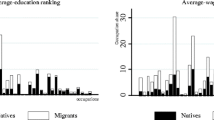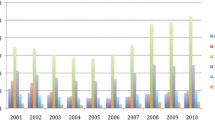Abstract
Immigrants in Germany have poor earnings performance relative to natives. Claiming that human-capital endowments determine earnings potentials rather than actual earnings, a stochastic earnings frontier is estimated and used to seek systematic differences between natives and migrants for GSOEP data for the year 2000. While empirical results clearly support the frontier assumption, natives and immigrants are surprisingly about the same with respect to the frontier. Assuming a half-normal distribution of the wage gap, on average, both groups transform a modest 84% share of their potential income into market earnings. This implies wage inequality can be attributed to human-capital differentials alone. The human-capital endowments of immigrants are largely determined by the very low percentage who have college degrees, their slow assimilation and zero-return on imported experience. The paper also tries to explain individual wage gaps, which are significantly decreased in married subjects raising families, but increased in employees in small- or medium-sized relative to larger firms. However, these variables only make minor contributions to the variance.
Similar content being viewed by others
References
Aigner, D., Lovell, C. and Schmidt, P.: Formulation and estimation of stochastic frontier production models, Journal of Econometrics 6 (1977), 21–37.
Battese, G.E. and Coelli, T.J.: A model for technical inefficiency effects in a stochastic frontier production function for panel data, Empirical Economics 20 (1995), 325–332.
Borjas, G.J.: Assimilation, changes in cohort quality, and the earnings of immigrants, Journal of Labor Economics 3 (1985), 463–489.
Borjas, G.J.: The economics of immigration, Journal of Economic Literature 32 (1994), 1667–1717.
Chiswick, B.R.: Americanization and the earnings of foreign-born men, Journal of Political Economy 86 (1978), 897–921.
Daneshvary, N., Herzog, H.W. Jr., Hofler, R.A. and Schlottmann, A.M.: Job search and immigrant assimilation: An earnings frontier approach, Review of Economics and Statistics 74 (1992), 482–492.
Eckstein, Z. and Weiss, Y.: On the wage growth of immigrants: Israel, 1990–2000, Journal of the European Economic Association 2 (2004), 665–695.
Farrell, M.J.: The measurement of productive efficiency, Journal of the Royal Statistical Society A 120 (1957), 253–281.
Fried, H.O., Lovell, C.A.K. and Schmidt, S.S. (eds.): The Measurement of Productive Efficiency: Techniques and Applications, Oxford University Press, Oxford, 1993.
Greene, W.H.: The econometric approach to efficiency analysis, In: H.O. Fried, C.A.K. Lovell and S.S. Schmidt (eds.), The Measurement of Productive Efficiency: Techniques and Applications Oxford University Press, Oxford, 1993, pp. 68–119.
Herzog, H.W. Jr., Hofler, R.A. and Schlottmann, A.M.: Life on the frontier: Migrant information, earnings and past mobility, Review of Economics and Statistics 67 (1985), 373–382.
Hofler, R.A. and Polachek, S.: A new approach for measuring wage ignorance in the labor market, Journal of Economics and Business 37 (1985), 267–276.
Hunt-McCool, J.C. and Warren, R.S. Jr.: Earnings frontiers and labor market efficiency, In: H.O. Fried, C.A.K. Lovell and S.S. Schmidt (eds.), The Measurement of Productive Efficiency: Techniques and Applications, Oxford University Press, Oxford, 1993, pp. 197–209.
Jondrow, J., Lovell, C.A.K., Materov, I.S. and Schmidt, P.: On the estimation of technical inefficiency in the stochastic frontier production function model, Journal of Econometrics 19 (1982), 233–238.
Korenman, S. and Neumark, D.: Does marriage really make men more productive?, Journal of Human Resources 26 (1991), 282–307.
Licht, G. and Steiner, V.: Assimilation, labour market experience, and earnings profiles of temporary and permanent immigrant workers in Germany, International Review of Applied Economics 8 (1994), 130–156.
Loeffelholz, H.D.v. and Küpp, G. (eds.), Ökonomische Auswirkungen der Zuwanderungen nach Deutschland, Duncker & Humblodt, Berlin, 1998.
Lundberg, S. and Rose, E.: The effects of sons and daughters on men’s labor supply and wages, Review of Economics and Statistics 84 (2002), 251–268.
Meeusen, W. and van den Broeck, J.: Efficiency Estimation from Cobb–Douglas production functions with composed error term, International Economic Review 18 (1977), 435–444.
Mincer, J.: Schooling, Experience and Earnings, Columbia University Press, New York, 1974.
Oaxaca, R.: Male–female wage differentials in urban labor markets, International Economic Review 14 (1973), 693–709.
Pannenberg, M.: Documentation of panel sizes and panel attrition in the German socio economic panel (GSOEP), Discussion Paper 196, Berlin, Deutsches Institut für Wirtschaftsforschung, 2000.
Pischke, J.-S.: Assimilation and the earnings of guestworkers in Germany, (mimeo), Massachusetts Institute of Technology, 1993.
Polachek, S.W. and Robst, J.: Employee labor market information: Comparing direct world of work measures of workers’ knowledge to stochastic frontier estimates, Labour Economics 5 (1998), 231–242.
Polachek, S.W. and Yoon, B.J.: Panel estimates of a two-tiered earnings frontier, Journal of Applied Econometrics 11 (1996), 169–178.
Robinson, M.D. and Wunnava, P.V.: Measuring direct discrimination in labor markets using a frontier approach: Evidence from CPS female earnings data, Southern Economic Journal 56 (1989), 212–218.
Schmidt, C.M.: Immigrant performance in Germany: Labor earnings of ethnic German migrants and foreign guest workers, The Quarterly Review of Economics and Finance 37 (1997), 379–397.
Wang, H.-J. and Schmidt, P.: One-step and two-step estimation of the effects of exogenous variables on technical efficiency levels, Journal of Productivity Analysis 18 (2002), 129–144.
Author information
Authors and Affiliations
Corresponding author
Rights and permissions
About this article
Cite this article
Lang, G. The difference between wages and wage potentials: Earnings disadvantages of immigrants in Germany. J Econ Inequal 3, 21–42 (2005). https://doi.org/10.1007/s10888-004-7581-4
Received:
Accepted:
Issue Date:
DOI: https://doi.org/10.1007/s10888-004-7581-4




